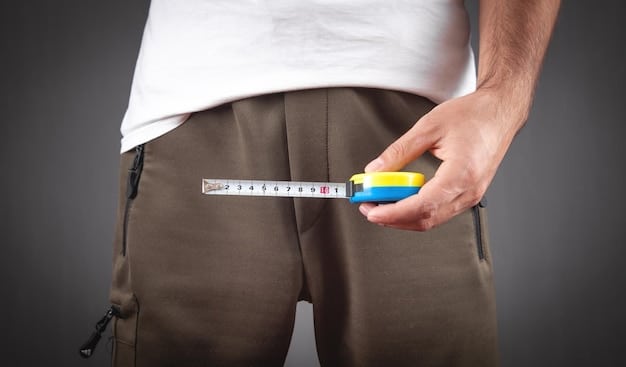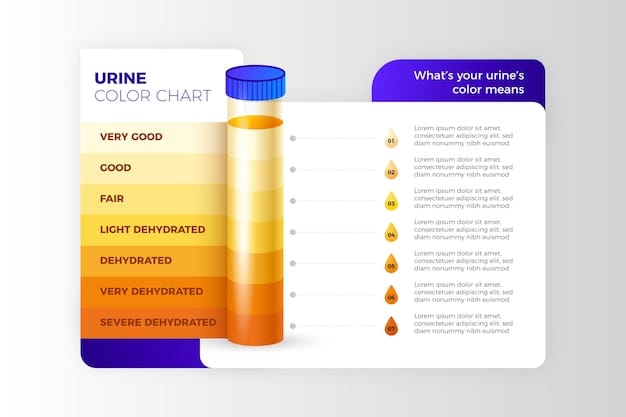The Ultimate Guide to Condom Sizes: Find Your Perfect Fit

Choosing the right condom size is crucial for both comfort and effective protection against STIs and unintended pregnancies; this guide provides comprehensive information to help you find your perfect fit, ensuring a safer and more enjoyable sexual experience.
Choosing the right condom size can significantly impact your comfort and safety. This The Ultimate Guide to Choosing the Right Condom Size for Maximum Protection and Comfort will walk you through everything you need to know to ensure a perfect fit, enhancing your sexual experience and providing reliable protection.
Understanding Condom Sizes: Why It Matters
Condoms are a primary tool for preventing sexually transmitted infections (STIs) and unintended pregnancies. However, their effectiveness depends heavily on proper use, and a crucial aspect of this is selecting the correct size. A condom that is too small can be uncomfortable and may break during use, while one that is too large can slip off, leaving you unprotected. Understanding the importance of condom sizes is the first step towards ensuring safer sex.
The Risks of Ill-fitting Condoms
Using the wrong condom size can lead to several issues. Condoms that are too tight can increase the risk of breakage due to excessive pressure. On the other hand, condoms that are too loose might slip off during intercourse, negating their protective function. Both scenarios significantly raise the chances of STIs and unplanned pregnancies. Therefore, taking the time to find the right fit is essential for your sexual health and peace of mind.
Debunking Myths About Condom Sizes
There are many misconceptions surrounding condom sizes. One common myth is that “one size fits all.” This is far from the truth, as men’s anatomy varies significantly. Another misconception is that larger condoms are always better. In reality, an oversized condom can be just as risky as one that is too small. It’s important to rely on accurate measurements and sizing guides rather than assumptions.
- Myth: One size fits all.
- Fact: Condom sizes vary to accommodate different anatomies.
- Myth: Larger is always better.
- Fact: An oversized condom can slip off and provide inadequate protection.
- Myth: Condom size doesn’t affect sensitivity.
- Fact: A properly fitted condom can enhance comfort and sensitivity.
Understanding these points is crucial for making informed decisions about condom sizes. Accurate information empowers you to prioritize your sexual health and ensure the efficacy of condoms.
How to Measure for the Right Condom Size
Measuring yourself for the right condom size is a straightforward process that can greatly improve your sexual health and comfort. The two key measurements to consider are length and girth (circumference). Here’s a comprehensive guide to help you accurately measure yourself.
Step-by-Step Guide to Measuring Girth
Girth, or circumference, is the most important measurement when determining condom size. Here’s how to measure it accurately:
- Get Equipped: You’ll need a soft measuring tape or a piece of string and a ruler.
- Achieve an Erection: Measure your penis when it is fully erect, as this is when it is at its largest.
- Wrap the Tape: Wrap the measuring tape around the thickest part of your erect penis. This is usually around the midshaft.
- Note the Measurement: If using a measuring tape, note the circumference directly. If using string, mark where the string overlaps and then measure the length of the string with a ruler.
Measuring Length: Is It Necessary?
While girth is the primary factor, length can also play a role in comfort. To measure length:
- Start at the Base: Place the end of the measuring tape at the base of your penis, where it meets your body.
- Measure to the Tip: Extend the tape to the tip of your penis.
- Record the Length: Note the measurement in inches or millimeters.
However, most condom manufacturers focus on girth, as it impacts fit and safety more significantly than length.
Using Online Sizing Charts
Once you have your measurements, you can use online sizing charts provided by condom manufacturers. These charts typically correlate girth measurements with specific condom sizes. Compare your measurements with multiple charts, as sizing can vary slightly between brands.

Measuring yourself accurately and consulting sizing charts will ensure you choose a condom size that fits well, providing both comfort and reliable protection.
Understanding Condom Packaging and Sizing Terms
Navigating the world of condom packaging can be confusing, with various terms and measurements displayed. Understanding these terms is essential to making an informed choice and finding the right fit. Let’s break down the key elements you’ll find on condom packaging.
Decoding Condom Box Information
Condom boxes typically include several pieces of information, including:
- Nominal Width: This is the most important measurement and refers to the width of the condom when laid flat. To find the circumference the condom will fit, multiply this number by two.
- Length: This is the length of the condom from base to tip.
- Material: Condoms are usually made of latex, polyurethane, or polyisoprene.
- Lubrication: Indicates whether the condom is lubricated and, if so, what type of lubricant is used (e.g., silicone-based, water-based).
- Expiration Date: Always check the expiration date to ensure the condom is still effective.
Common Sizing Terms: Snug, Standard, Large
Condom manufacturers often use terms like “snug,” “standard,” or “large” to indicate size. Here’s what these terms generally mean:
- Snug Fit: These condoms are designed for men with a smaller girth, providing a tighter fit for enhanced sensitivity and reduced slippage.
- Standard: This is the most common size, suitable for men with an average girth.
- Large/Magnum: These condoms are designed for men with a larger girth, offering more room and reducing the risk of breakage.
Comparing Different Brands and Their Sizes
It’s important to note that sizing can vary between brands. What one brand considers “standard” might be slightly different in size compared to another. Always consult the specific sizing chart provided by each manufacturer. Some popular condom brands and their sizing nuances include:
- Durex: Offers a range of sizes, with detailed sizing charts available on their website.
- Trojan: Known for their Magnum line, designed for larger sizes, but also offers standard and smaller sizes.
- Lifestyles: Provides various sizes and fits, including snug fit options.
By understanding condom packaging and sizing terms, you can confidently select the right condom size, ensuring both comfort and protection.
The Best Condom Materials: Latex, Polyurethane, and More
Condoms are available in several materials, each with its own advantages and disadvantages. The most common materials are latex, polyurethane, and polyisoprene. Understanding the properties of each material can help you make an informed choice based on your needs and preferences.
Latex Condoms: Pros and Cons
Latex condoms are the most widely used type of condom. Here are their pros and cons:
- Pros:
- Proven effectiveness in preventing STIs and pregnancy.
- Relatively inexpensive.
- Widely available.
- Cons:
- Some people are allergic to latex.
- Can degrade with oil-based lubricants.
Latex condoms are a reliable and cost-effective option, but they may not be suitable for individuals with latex allergies.
Non-Latex Options: Polyurethane and Polyisoprene
For those with latex allergies, non-latex condoms made from polyurethane or polyisoprene are excellent alternatives:
- Polyurethane:
- Thinner than latex, providing increased sensitivity.
- Compatible with both water-based and oil-based lubricants.
- Stronger than latex, reducing the risk of breakage.
- Polyisoprene:
- Feels more like latex, offering a comfortable fit.
- Highly elastic and durable.
- Suitable for those with mild latex sensitivities.
Choosing the Right Material for Your Needs
When selecting a condom material, consider the following factors:
- Allergies: If you have a latex allergy, opt for polyurethane or polyisoprene condoms.
- Sensitivity: Polyurethane condoms are thinner and can enhance sensitivity.
- Lubricant Compatibility: Ensure the lubricant you use is compatible with the condom material. Water-based and silicone-based lubricants are generally safe for all condom types.

Selecting the right condom material ensures comfort, safety, and enhanced pleasure during sexual activity.
Tips for Using Condoms Correctly
Using condoms correctly is crucial for their effectiveness in preventing STIs and unintended pregnancies. Even the best condom won’t provide adequate protection if used improperly. Here are some essential tips for correct condom usage.
Proper Storage and Handling
The way you store and handle condoms can significantly impact their integrity. Follow these guidelines:
- Store in a Cool, Dry Place: Avoid storing condoms in wallets, car glove compartments, or direct sunlight, as heat and friction can damage the latex.
- Check the Expiration Date: Always ensure the condom is not expired before use.
- Open Carefully: Use your fingers to tear open the package gently. Avoid using your teeth or sharp objects, which can damage the condom.
Applying a Condom: Step-by-Step
Applying a condom correctly is simple but requires attention to detail:
- Check for Damage: Before opening the package, feel the condom wrapper to ensure it contains air, indicating no damage.
- Pinch the Tip: After opening, pinch the tip of the condom to remove any air. This prevents air from getting trapped, which can cause breakage.
- Roll Down: Place the condom on the tip of the erect penis and roll it down to the base.
- Smooth Out Air Bubbles: Ensure there are no air bubbles trapped under the condom.
After Sex: Safe Removal and Disposal
After sex, proper removal and disposal are important:
- Hold the Base: While the penis is still erect, hold the base of the condom to prevent it from slipping off.
- Withdraw Carefully: Withdraw from your partner carefully, still holding the base of the condom.
- Dispose Properly: Wrap the used condom in a tissue and dispose of it in a trash can. Do not flush condoms down the toilet.
Following these tips ensures that condoms are used correctly, maximizing their effectiveness in protecting against STIs and unplanned pregnancies.
Addressing Common Condom Concerns
Many people have questions and concerns about using condoms, ranging from comfort and sensitivity to potential allergic reactions. Addressing these concerns can help promote safer and more enjoyable sexual experiences.
Dealing with Sensitivity Issues
Some individuals report decreased sensitivity when using condoms. Here are some strategies to enhance sensitivity:
- Use Thin Condoms: Opt for ultra-thin latex or polyurethane condoms for increased sensitivity.
- Try Lubricated Condoms: Lubrication can enhance sensitivity and reduce friction.
- Experiment with Different Textures: Some condoms have textured surfaces that can stimulate both partners.
Managing Latex Allergies
For those with latex allergies, non-latex options such as polyurethane or polyisoprene condoms are available. These materials provide effective protection without causing allergic reactions.
Preventing Slippage and Breakage
Slippage and breakage are common concerns when using condoms. To prevent these issues:
- Choose the Right Size: Ensure the condom fits properly.
- Use Lubrication: Adequate lubrication reduces friction and the risk of breakage.
- Avoid Oil-Based Lubricants with Latex Condoms: Oil-based lubricants can degrade latex, increasing the risk of breakage.
Addressing these common concerns can improve the overall experience of using condoms, making them a more reliable and comfortable option for safe sex.
| Key Point | Brief Description |
|---|---|
| 📏 Measuring Girth | Use a soft measuring tape to measure around the thickest part of your erect penis. |
| 🔍 Checking Packaging | Look for nominal width, lubrication, material, and expiration date on the condom box. |
| ✅ Correct Application | Pinch the tip, roll down, remove air bubbles, and store properly. |
| 🛡️ Material Choice | Consider latex, polyurethane, or polyisoprene based on allergies and sensitivity. |
Frequently Asked Questions
▼
A condom is the right size if it stays in place without slipping and doesn’t feel too tight. You should be able to roll it down easily and have a snug, but comfortable, fit.
▼
Reliable sizing charts can be found on condom manufacturer websites, such as Durex, Trojan, and Lifestyles. These charts correlate girth measurements with specific condom sizes.
▼
No, using two condoms at once is not recommended. It can cause friction between the condoms, increasing the risk of breakage. One properly fitted condom is sufficient.
▼
If a condom breaks, stop immediately. If you are not using other forms of contraception, consider emergency contraception. Both partners should get tested for STIs.
▼
Flavored condoms are primarily designed for oral sex. They may contain sugars that can increase the risk of yeast infections if used for vaginal sex. Use unflavored condoms for vaginal sex.
Conclusion
Choosing the right condom size is a pivotal step toward ensuring both maximum protection and comfort during sexual activity. By taking accurate measurements, understanding condom packaging, and considering personal preferences such as material and sensitivity, you can significantly enhance your sexual health and overall experience. Prioritizing this aspect of sexual wellness empowers you to make informed choices, promoting safer and more satisfying encounters.





